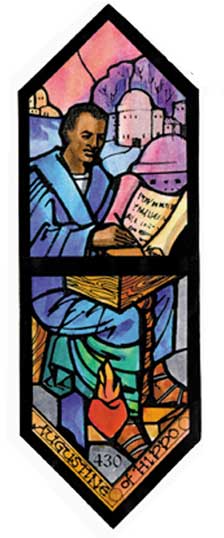|
|
|||

|
|||
Augustine of Hippo
Window
 By the end of the fourth century, the Western Roman Empire was crumbling, and in 410, Rome was sacked. In the East, the Byzantine Empire and Imperial Church continued; in the West chaos reigned as wave after wave of Germanic invaders flooded across the borders of the Empire. Augustine of Hippo watched the light go out across the western world. He was born in North Africa in A.D. 354, and as a young man he enjoyed the pleasures of life in the last decadent years of the Empire. But his soul was tormented, and soon he embarked on a long, arduous search for the truth. Though he finally became convinced of Christianity, he wrestled with giving up his lifestyle, and penned his famous prayer: “Give me chastity and continence; but not too soon.” Augustine’s struggle continued until one day he heard a child singing the words, “take and read.” Moved in his spirit, Augustine picked up the letters of St. Paul which he had been studying, and read there Paul’s words to put on the Lord Jesus Christ, and stop gratifying the desires of the flesh. Suddenly his heart was opened, his mind was made up, and he was baptized, devoting his life entirely to devotions, study, and meditation. But his fame spread, and soon he was made a priest, and then bishop of Hippo, much against his will. It was then he began the writing that would make him the most influential theologian in the history of the Western Church. His spiritual autobiography, Confessions, stands alone in all of ancient literature, revealing a self-awareness and depth of soul that are not reached again for 1500 years. But his masterpiece, written in response to the fall of Rome, was The City of God, a sweeping history of civilization centered on two cities, the one earthly and temporal, the other heavenly and eternal. Augustine died in 430, as the Vandals were besieging his own earthly city of Hippo. Augustine is honored in our windows as one of the greatest theologians of the church. He is shown writing, for which he is famed. Hippo is in the background. The flaming heart at the base of the window brings to mind his prayer, “Almighty God, you have made us for yourself, so that our hearts are restless till they rest in you.”
Like Stars Appearing: The Story of the Stained Glass
Windows of St. George's Episcopal Church, Dayton, Ohio
| |||
|
|||
